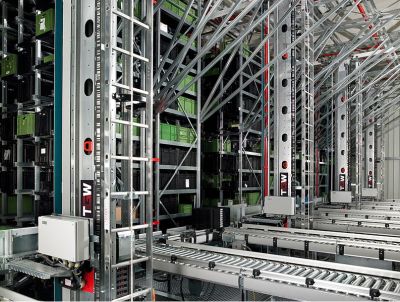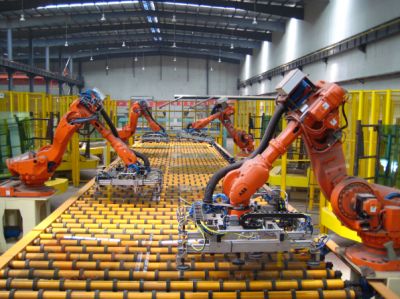Are Fully-Automated Distribution Centers A Realistic Option For Your Business?
JD, in case you don’t know, is an enormous e-commerce retailer with expansive operations in the Far East, especially China. Although Alibaba is usually defined as the Amazon of Asia, JD is actually more structurally similar to Jeff Bezos’ firm. JD, like Amazon, mainly lists its own products, while setting aside some space on its platform for third-party providers.
JD, like Amazon, is also obsessed with reducing costs, cutting fulfillment times, and automating its warehouses. But JD may be further along than its US counterpart. In 2018, the company opened a warehouse that could process 200,000 orders per day that employs just four people – robots oversee the rest of the operation.
The idea that robots could do everything from selecting products on shelves, transporting them to the packaging stations, wrapping them in a suitable material, and then depositing them in the back of vans for delivery sounds a little far-fetched, but this is what the company says it has achieved. The job of the four people who work on the site is to make sure that the equipment works as intended – nothing more.
Observers of JD can understand why the firm is so keen on automation. Its warehouse requirements are enormous and continue to grow exponentially over time. After years of holding back on spending, the Chinese consumer market is booming, and the country is fast approaching consumption levels similar to those in the West, especially in the major coastal cities.
JD wants to avoid higher labor costs impacting the price of the goods that it sells, so it’s trying to do its bit to cut out the middleman and get robots to fill in the gaps. The increasing capabilities of robots have passed by the mainstream media, but not companies like JD who rely on machines to fulfill the hundreds of thousands of orders the company receives every hour.
The automation of the factory itself involves an enormous collaboration between AI experts, chain conveyor manufacturers, and robotics firms. No single company so far offers an end-to-end solution for a fully automated warehouse, but JD has brought together a variety of suppliers in a clever combination to make it happen.
The new automated warehouse is located in a place called Kunshan. Trucks arrive with the goods at one side of the facility where they are loaded onto conveyor belts and a network of automated machinery and then taken to storage.
Image scanners identify each package and then products to appropriate bins to group products destined for particular parts of the country. The whole factory is, in a sense, a giant brain, coordinated by a single integrated program that understands what it needs to do and where various packages need to be. It’s impressive to watch.
Can Other Businesses Do The Same?
What’s so incredible about what JD has achieved is how early it managed to do it. Most commentators believed that fully automated warehouses (with no forklift trucks) would arrive sometime in the mid-2020s. But JD’s efforts to become the market leader put even Amazon to shame.
The company has somehow managed to get ahead of the technological curve – as Tesla has with batteries – and prove to the world that full-scale automation technologies are ready for primetime now.
The question for many entrepreneurs is whether they can replicate what JD has done and cut down on their labor costs. It’s a nice idea but still out of reach for practically all firms. Even Amazon, with all its billions of dollars, hasn’t got anything that can compete directly with JD’s Kunshan warehouse. Sure, Amazon uses robots to ferry products from one part of its warehouses to another – and it’s been invested in robots heavily – but it still relies on legions of low-paid packers to carry out work.
The only opportunity for businesses is likely to be if Amazon or an independent fulfillment provider starts offering their own end-to-end fully automated services. For a company to do what JD has done would require enormous expense and the ability to bring together the best and brightest people in the world to ensure that the solution worked – something that’s not possible for many.
The Promise Of Robot Warehouses
Robot warehouses are coming. In many ways, they’re already with us. But they’re likely to be the first industry that falls to full automation. The reason for this has to do with regulation: governments are far less likely to apply strict regulatory standards to automated factories than they are, say, autonomous vehicles.
Warehouses operate on private land, and there are no immediate safety issues that need to be addressed. Companies can invest in automation technology, slowly cutting their labor costs, until there’s no need to employ people at all.
Robot warehouses don’t completely solve the problem of the high cost of fulfillment and shipping for online retailers. Yes, it’s excellent at cutting labor costs, but all those machines need the energy to whizz from one side of a facility to another, which may push up energy bills.
Companies like JD also still need to deal with the issue of how to cut the labor cost of making deliveries. Once the items pop out of the other end of the warehouse, somebody has to drive them to customers and deliver them. Automated warehouses cut out some of the total cost of delivering items to customers, but there are other far-most costly hurdles to overcome.
Finally, there’s the issue of whether automating distribution centers is economically feasible. JD may have lowered the cost of fulfilling the marginal order, but it had to stump up a lot of money to put the system in place. That cost still needs to be paid for.
This issue of cost is the fundamental issue facing all implementations of automation technology. Not only does it have to work and be technologically feasible, but it also has to be better from a financial perspective than current systems. Sure, the costs will come down, but that process may take more than a decade to complete.
Are you thinking about going with a fully automated distribution center for your business?







